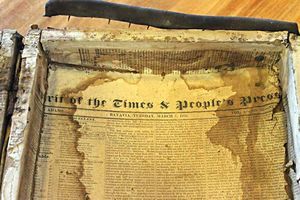By Matt Surtel msurtel@batavianews.com
BATAVIA — The trunk looks hand-hewn, deteriorated, and very, very old.
But that’s only natural for the 160-year-old artifact on display in Williamston, Mich.
It’s part of a collection — and a city — with significant Batavia roots, as Mitch Lutzke described Friday in a telephone interview.
Even the city’s name.
“In Michigan, we’re pretty in-tune that the bulk of our early settlers came from New York,” he said. “When the Erie Canal opened, it made passageway from basically Buffalo to Detroit, to the hinterlands of the journey to move to out west, and Michigan was basically out west in the 1820s.”
Lutzke is vice president of the Williamston Depot Museum. He describes the city as a “sub-suburb” of Lansing, in the south-central third of the state.
It has about 3,800 people, including a good proportion of state legislators, college professors, and even some retired professional athletes.
But the city’s roots have a major Batavia pedigree, including three Batavia brothers.
Horace, Oswald and James Miles Williams journeyed west to what’s now the Grand River back in 1839. They settled about 15 miles east of Lansing.
At that point, Michigan was “out west,” and they were among maybe 150 people in a very sparsely-populated area, Lutzke said.
The brothers dammed the river, constructed a sawmill and gristmill. As the years passed, more family members moved out to the area, and the brothers also became involved in farming and business.
The resulting town went through several names, before eventually becoming the family’s namesake as Williamston.
Fast-forward to about four years, ago, and James Miles Williams’ great-granddaughter donated 17 boxes of materials to Williamston Depot Museum — which contained a minor treasure trove of items rooted in Batavia, and are now displayed at the facility.
Chief among them was James Miles Williams’ trunk, which he apparently built himself. It was lined with a March 8, 1831, copy of the long-defunct “Spirit of the Times & People” newspaper, which was once published in Batavia.
Lutzke said the remaining boxes included china, personal papers, and James Miles’ Williams readings. The latter included political speeches, along with published followings on the post-Civil War Reconstruction, and monetary policy.
Three or four other Batavia families followed the Williams brothers after their move, Lutzke added. Among the local lore is that a few later visited Batavia and brought back lily pads — maybe from the Tonawanda Creek — that continued to grow in the area, until the Grand River was dredged in the 1970s.
So although people may not realize it, Batavia remains in the spotlight, in a perhaps-unexpected portion of Michigan. Lutzke himself is a native of that state’s Albion, which was rumored to have been named after its Orleans County counterpart.
“You’re actually familiar with community ties in middle and Western New York,” Lutzke said, describing southern Michigan’s sense of history. “It’s not that rare ... so when we know people have to come from someplace, Batavia is as good as any.”





